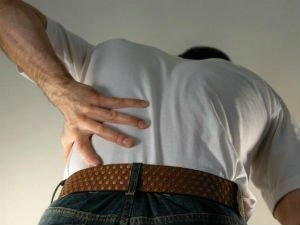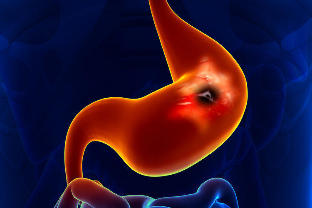When there is a pain in the back left side, a lot of people are beginning to suspect disease of the vertebral column. But by far not only a pathology of the spine can cause unpleasant symptoms. Almost 95% of the people, after the age of 35, begin to experience pain in the back.

There are many causes of able to its cause: the malfunction of the internal organs, colds, hypothermia, physical inactivity, poor posture, and many others. Do not start perform steps of treatment, if the pain in the left part of the back. Only an experienced specialist is true recognizes the condition and will prescribe you a treatment. And until the result is worth reviewing the possible causes of the disease.
The cause of the discomfort
Before you start to follow a treatment, you have to find the cause of the pain, install it to a precise location. Perhaps, the reason became the overuse of the muscles due to the high physical load or cold. Here is the main pathology, which the backache left.
Intercostal neuralgia
The syndrome of pain, which occurs during the compression, irritation or inflammation of the nerves, which are located between the ribs. The causes of the disease are rather numerous. The main of them, we can cite: an allergic reaction, diseases of the nervous system, reducing immune power of the body, tumors of the lung or of the pleura, of hypothermia, of certain infectious diseases (tuberculosis, herpes zoster), and back injuries of the chest, diseases of the spine (scoliosis, intervertebral hernia, etc). With the defeat of one of the nerves of the left hurt the left side of the chest, aggravated by movement or inspiration, marked by the increase of the sweat, the tears, the goosebumps, the numbness of the affected areas, sleep disorders.
Pyelonephritis
The kidney disease, which is associated with lesions of the parenchyma, calyx pelvis of kidney. In most cases, pyelonephritis develops due to the presence of infectious agents in the bladder, which climb on the urtres. Also contribute to the development of the pathology and other diseases: kidney stones, diabetes, diseases of the organs of the female reproductive system, etc
The symptoms of kidney disease are a pain in the lumbar region, with the affected side, which gives the area of the pubis, fatigue and discomfort, an increase in temperature and the excessive sweating, the urine becomes cloudy and takes on a reddish hue, in the analysis of the urine will be updated on a protein and which contained the bacteria in the blood increases the erythrocyte SEDIMENTATION rate and leukocytosis.
Urolithiasis
A disease in which the organs of the urinary device includes a solid education in the form of stones. These stones do not have other crystals of dissolved salts in the urine. At the onset of the disease is the result of the presence of several causes: a genetic predisposition, consumption of water containing a large amount of mineral salts, lack of fluid consumption, physical inactivity. Depending on the location of the pain, the doctor can understand exactly where the stone.
To confirm this, you can use conducted by LINKS-study. In addition to the pain in the back, patients experience pain and burning sensations in the lower abdomen above the pubis and in the urethra, an increase in body temperature, renal colic, disorder of the urine of the blood.
Myocardial infarction
The form of coronary artery disease, characterized by the necrosis of the heart muscle, insufficiency of blood supply. Most often the disease occurs in men aged 45 years. The causes of the infarct may become diabetes, obesity, hypertension, alcohol abuse, smoking, mental stress.
The strong psycho-emotional surge can cause infarct in the bottom of the coronary heart disease and angina pectoris. The clinical manifestations are tingling and severe pain in the region of the heart, which may radiate into the left arm, jaw, shoulder blade, lower back. In addition, shortness of breath, cold clammy sweat, a feeling of lack of air and the feeling of the fear of death, acrocyanosis .
Ulcer of the stomach

A chronic disease characterized by the appearance of sores in the lining of the stomach. The pathology is subject to frequent relapses, progression, and the onset of complications. Develops an ulcer of the stomach, for a few reasons: prior to the diseases of the digestive system, the effects of the bile, hydrochloric acid, and the prolonged intake of anti-inflammatory medications non-steroidal anti-inflammatory drugs, ischemia gastric tissue.
There is evidence that heredity plays an important role, and there are cases of morbidity between blood relatives. For the ulcer disease is characterized by the presence of pain in the upper abdomen under the xiphoid appendix), and sometimes it may give in the back or right upper quadrant. Usually, patients can dotted line, specify the location of the location of the bad symptoms. In addition to the pain, patients complain of feeling of heaviness, filling the stomach on an empty stomach or after taking food, a disorder of the chair, nausea, vomiting, leading to the elimination of unpleasant symptoms, aches and pains.
Pneumothorax
A pathological condition in which occurs an accumulation of air or gas in the pleural cavity. The reason its become diseases of the respiratory system, trauma, malignancies, connective tissue diseases, tuberculosis, etc, is more common among people aged 20 to 40 years.
Develops pneumothorax always all of a sudden and the severity of the symptoms depends on the extent of the fall of the lung. The main symptoms of the disease is considered to be: a sharp pain on the top of the chest of the hand, which is amplified during inhalation, and may give to hand, a dry cough, dyspnea, cyanosis of the skin, cold clammy sweat, decreased blood pressure, and sometimes fainting. When the shape of a pneumothorax, you can observe the blood from the wound.
Pulmonary tuberculosis
A serious infectious disease affecting the lung tissue. Pulmonary tuberculosis the most common form of the disease. The cause of the disease – the bacillus of Koch. Provoking factors for reproduction are unfavourable conditions and certain diseases, which are strongly weaken the immune system: smoking, HIV infection, receipt of special products, diabetes, cancer, chronic kidney failure, and other.
Also at higher risk are people in places of deprivation of liberty, migrants, drug addicts, and alcoholics. First, the development of the disease does not have symptoms or they are mild and occur in the form of a cold. The cough is missing or appears rarely with the passage of sputum viscous, with an unpleasant smell, bad back to the left or to the right when the defeat of the lung with one of the parties. Also, patients complain about an increase of fatigue, sweating, low-grade fever of the body, lymph nodes, heart palpitations, sometimes hemoptysis.
In women the cyst of the left ovary
A benign form of the tumor with liquid content inside and an upward trend. The appearance of a cyst is related to the violation of menstruation, the disorders of the endocrine system and the wrong train of life. The pathology does not depend on age. First, the tumour is not manifest. The only symptom may be pulling pain in the lower belly.
When you need emergency consultation with the doctor
If the evil of the left part of the back and the pain subsides, and then, a few days later, hardly to suspect a serious illness requiring immediate medical.
Also, do not overlook the emergence, and other clinical signs:
- suddenly a sharp pain in the abdomen;
- is not reasonable for the loss of the mass of the body;
- an improper use of the digestive tract and the genito-urinary tract;
- a strong weakness, increasing the body's temperature.
Necessary investigation

To diagnose the disease, you must pass a comprehensive examination. The doctor can be assigned to one of the following types of research: blood on the clinical examination and biochemical analysis, urine analysis, electrocardiography, ULTRASOUND, x-ray or fluorographie, if necessary, MRI and CT, blood and other biological material on the markers.


























